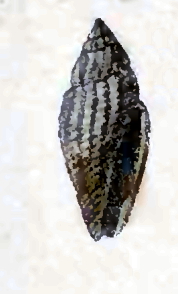Biology:Eucithara angiostoma
From HandWiki
Short description: Species of gastropod
| Eucithara angiostoma | |
|---|---|

| |
| Drawing of a shell of Eucithara angiostoma | |
| Scientific classification | |
| Domain: | Eukaryota |
| Kingdom: | Animalia |
| Phylum: | Mollusca |
| Class: | Gastropoda |
| Subclass: | Caenogastropoda |
| Order: | Neogastropoda |
| Superfamily: | Conoidea |
| Family: | Mangeliidae |
| Genus: | Eucithara |
| Species: | E. angiostoma
|
| Binomial name | |
| Eucithara angiostoma (Pease, 1868)
| |
| Synonyms[1] | |
| |
Eucithara angiostoma is a small sea snail, a marine gastropod mollusk in the family Mangeliidae.[1]
This is not Eucithara angiostoma Kay, 1979
Description
The length of the shell varies between 3 mm and 5 mm.
The longitudinal ribs are oblique. The transverse striae are very fine but distinct. The inner and outer lips are both corrugated. The color of the shell is whitish, with a broad central brown band on the back of the body whorl, which when the shell is worn appears as a spot.[2]
Distribution
This marine species occurs in the Indian Ocean (?), Polynesia, the Philippines .
References
- ↑ 1.0 1.1 WoRMS (2009). Eucithara angiostoma (Pease, 1868). In: MolluscaBase (2017). Accessed through: World Register of Marine Species at http://www.marinespecies.org/aphia.php?p=taxdetails&id=433686 on 2017-05-02
- ↑ G.W. Tryon (1884) Manual of Conchology, structural and systematic, with illustrations of the species, vol. VI; Philadelphia, Academy of Natural Sciences
- Pease, W. H. 1868. Synonymy of marine gastropodae inhabiting Polynesia. American 1. Conch. 4: 103-132
External links
- Tucker, J.K. 2004 Catalog of recent and fossil turrids (Mollusca: Gastropoda). Zootaxa 682:1-1295.
- "Eucithara angiostoma" (in en). Gastropods.com. http://www.gastropods.com/9/Shell_19079.shtml.
- Kilburn R.N. 1992. Turridae (Mollusca: Gastropoda) of southern Africa and Mozambique. Part 6. Subfamily Mangeliinae, section 1. Annals of the Natal Museum, 33: 461–575
Wikidata ☰ Q4940866 entry
 |

